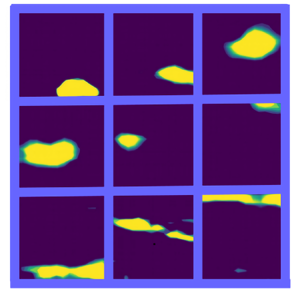Published online by Cambridge University Press: 11 June 2021

Identification of coherent structures is an essential step to describe and model turbulence generation mechanisms in wall-bounded flows. To this end, we present a clustering method based on latent Dirichlet allocation (LDA), a generative probabilistic model for collection of discrete data. The method is applied to a set of snapshots featuring the Reynolds stress ( $Q_-$ events) for a turbulent channel flow at a moderate Reynolds number
$Q_-$ events) for a turbulent channel flow at a moderate Reynolds number  $R_{\tau }=590$. Both two- and three-dimensional analysis show that LDA provides a robust and compact flow description in terms of a combination of motifs, which are latent variables inferred from the set of snapshots. We find that the characteristics of the motifs scale with the wall distance, in agreement with the wall-attached eddy hypothesis of Townsend (Physics of Fluids, 1961, pp. 97–120). Latent Dirichlet allocation motifs can be used to reconstruct fields with an efficiency that can be compared with the proper orthogonal decomposition (POD). Moreover, the LDA model makes it possible to generate a collection of synthetic fields that captures the intermittent characteristics of the original dataset more clearly than its POD-generated counterpart. These findings highlight the potential of LDA for turbulent flow analysis, efficient reconstruction of actual fields and production of a new field with suitable statistics.
$R_{\tau }=590$. Both two- and three-dimensional analysis show that LDA provides a robust and compact flow description in terms of a combination of motifs, which are latent variables inferred from the set of snapshots. We find that the characteristics of the motifs scale with the wall distance, in agreement with the wall-attached eddy hypothesis of Townsend (Physics of Fluids, 1961, pp. 97–120). Latent Dirichlet allocation motifs can be used to reconstruct fields with an efficiency that can be compared with the proper orthogonal decomposition (POD). Moreover, the LDA model makes it possible to generate a collection of synthetic fields that captures the intermittent characteristics of the original dataset more clearly than its POD-generated counterpart. These findings highlight the potential of LDA for turbulent flow analysis, efficient reconstruction of actual fields and production of a new field with suitable statistics.